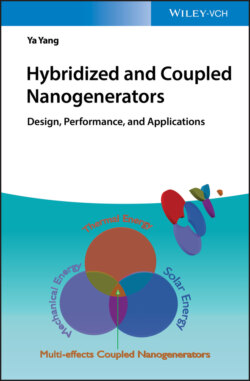Читать книгу Hybridized and Coupled Nanogenerators - Ya Yang - Страница 42
2.3.4.3 Polarization of Ferroelectric Materials
ОглавлениеFerroelectric materials, such as BiFeO3, Bi2FeCrO6, and BaTiO3, have been widely used in photovoltaic devices due to their abnormal photovoltaic effect. Usually, these materials need a polarization process, which could induce most of the domains along a fixed direction by applying a high external electric field. Conventional polarization apparatus exhibits some drawbacks including large volume, high cost, and safety issues.
Liu et al. developed an original polarization method, which could harvest ambient wind energy through the wind‐driven TENG to generate high output voltage pulse (of about 1000 V) leading to the polarization effect [75]. For the BaTiO3, a large piezoelectric constant of about 150 pC/N and a pyroelectric constant of about 14 nC/(cm2 K) were achieved by this method. Figure 2.16a illustrates the working principle of the polarization system. When the FEP film vibrated between two Cu electrodes due to the wind‐induced vibration, alternate output signals were formed in the external circuit based on a combined mechanism of contact electrification and electrostatic induction. By a rectifier, the primary output violated signals can be transformed to DC voltage pulses, which were used to polarize ferroelectric material with Ag electrodes. Figure 2.16b shows a photograph of a handheld TENG‐based polarization device. The piezoelectric constant could be increased with increasing the polarization time, as shown in Figure 2.16c. The piezoelectric constant of the BTO film was about 82 pC/N after a polarization time of about 20 s, as shown in Figure 2.16d.
